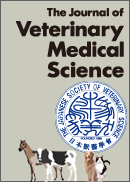Volume 71, Issue 6
June
Displaying 1-29 of 29 articles from this issue
- |<
- <
- 1
- >
- >|
Anatomy
-
Article type: FULL PAPER
2009 Volume 71 Issue 6 Pages 745-752
Published: 2009
Released on J-STAGE: July 04, 2009
Download PDF (456K) -
Article type: FULL PAPER
2009 Volume 71 Issue 6 Pages 759-762
Published: 2009
Released on J-STAGE: July 04, 2009
Download PDF (181K) -
Article type: NOTE
2009 Volume 71 Issue 6 Pages 821-824
Published: 2009
Released on J-STAGE: July 04, 2009
Download PDF (177K)
Bacteriology
-
Article type: FULL PAPER
2009 Volume 71 Issue 6 Pages 697-702
Published: 2009
Released on J-STAGE: July 04, 2009
Download PDF (165K) -
Article type: NOTE
2009 Volume 71 Issue 6 Pages 839-844
Published: 2009
Released on J-STAGE: July 04, 2009
Download PDF (224K) -
Article type: NOTE
2009 Volume 71 Issue 6 Pages 849-853
Published: 2009
Released on J-STAGE: July 04, 2009
Download PDF (157K)
Clinical Pathology
-
Article type: FULL PAPER
2009 Volume 71 Issue 6 Pages 769-777
Published: 2009
Released on J-STAGE: July 04, 2009
Download PDF (301K) -
Article type: NOTE
2009 Volume 71 Issue 6 Pages 835-838
Published: 2009
Released on J-STAGE: July 04, 2009
Download PDF (398K)
Internal Medicine
-
Article type: FULL PAPER
2009 Volume 71 Issue 6 Pages 763-768
Published: 2009
Released on J-STAGE: July 04, 2009
Download PDF (336K) -
Article type: NOTE
2009 Volume 71 Issue 6 Pages 785-787
Published: 2009
Released on J-STAGE: July 04, 2009
Download PDF (171K) -
Article type: NOTE
2009 Volume 71 Issue 6 Pages 789-792
Published: 2009
Released on J-STAGE: July 04, 2009
Download PDF (388K) -
Article type: NOTE
2009 Volume 71 Issue 6 Pages 817-820
Published: 2009
Released on J-STAGE: July 04, 2009
Download PDF (322K) -
Article type: NOTE
2009 Volume 71 Issue 6 Pages 827-829
Published: 2009
Released on J-STAGE: July 04, 2009
Download PDF (315K) -
Article type: NOTE
2009 Volume 71 Issue 6 Pages 845-848
Published: 2009
Released on J-STAGE: July 04, 2009
Download PDF (228K)
Laboratory Animal Science
-
Article type: FULL PAPER
2009 Volume 71 Issue 6 Pages 713-717
Published: 2009
Released on J-STAGE: July 04, 2009
Download PDF (349K) -
Article type: FULL PAPER
2009 Volume 71 Issue 6 Pages 729-736
Published: 2009
Released on J-STAGE: July 04, 2009
Download PDF (468K) -
Article type: FULL PAPER
2009 Volume 71 Issue 6 Pages 753-758
Published: 2009
Released on J-STAGE: July 04, 2009
Download PDF (308K)
Parasitology
-
Article type: FULL PAPER
2009 Volume 71 Issue 6 Pages 709-712
Published: 2009
Released on J-STAGE: July 04, 2009
Download PDF (211K) -
Article type: FULL PAPER
2009 Volume 71 Issue 6 Pages 779-783
Published: 2009
Released on J-STAGE: July 04, 2009
Download PDF (350K)
Pathology
-
Article type: NOTE
2009 Volume 71 Issue 6 Pages 831-833
Published: 2009
Released on J-STAGE: July 04, 2009
Download PDF (392K)
Pharmacology
-
Article type: FULL PAPER
2009 Volume 71 Issue 6 Pages 737-743
Published: 2009
Released on J-STAGE: July 04, 2009
Download PDF (317K) -
Article type: NOTE
2009 Volume 71 Issue 6 Pages 807-809
Published: 2009
Released on J-STAGE: July 04, 2009
Download PDF (202K)
Public Health
-
Article type: NOTE
2009 Volume 71 Issue 6 Pages 797-799
Published: 2009
Released on J-STAGE: July 04, 2009
Download PDF (204K) -
Article type: NOTE
2009 Volume 71 Issue 6 Pages 825-826
Published: 2009
Released on J-STAGE: July 04, 2009
Download PDF (137K)
Theriogenology
-
Article type: NOTE
2009 Volume 71 Issue 6 Pages 793-795
Published: 2009
Released on J-STAGE: July 04, 2009
Download PDF (139K) -
Article type: NOTE
2009 Volume 71 Issue 6 Pages 811-815
Published: 2009
Released on J-STAGE: July 04, 2009
Download PDF (192K)
Toxicology
-
Article type: FULL PAPER
2009 Volume 71 Issue 6 Pages 719-727
Published: 2009
Released on J-STAGE: July 04, 2009
Download PDF (433K)
Virology
-
Article type: FULL PAPER
2009 Volume 71 Issue 6 Pages 703-708
Published: 2009
Released on J-STAGE: July 04, 2009
Download PDF (346K) -
Article type: NOTE
2009 Volume 71 Issue 6 Pages 801-805
Published: 2009
Released on J-STAGE: July 04, 2009
Download PDF (298K)
- |<
- <
- 1
- >
- >|
